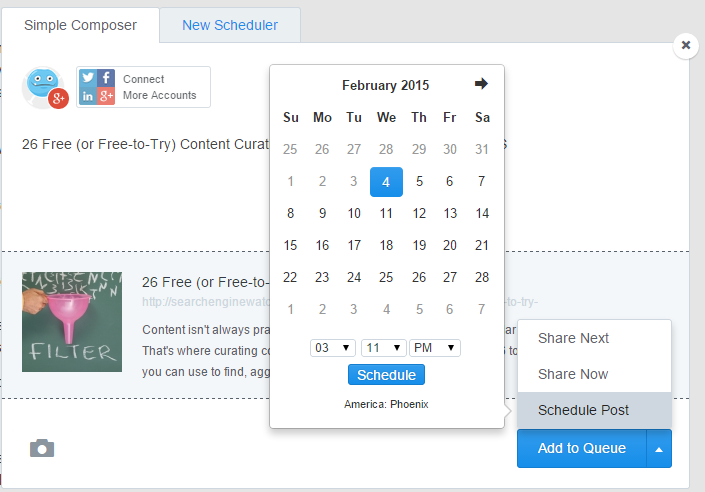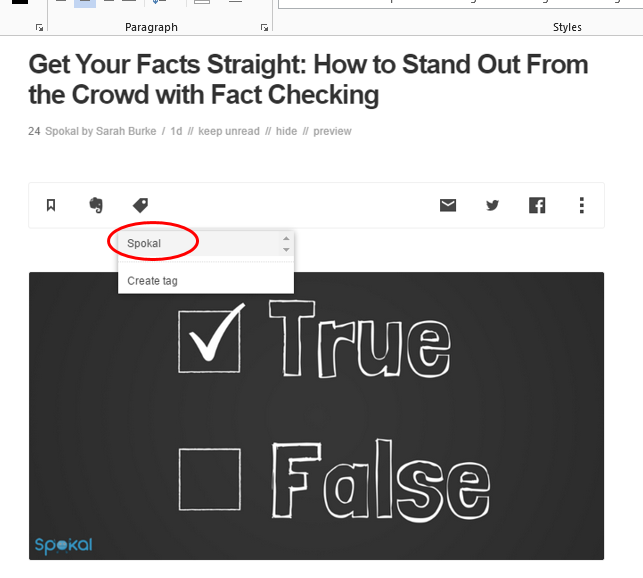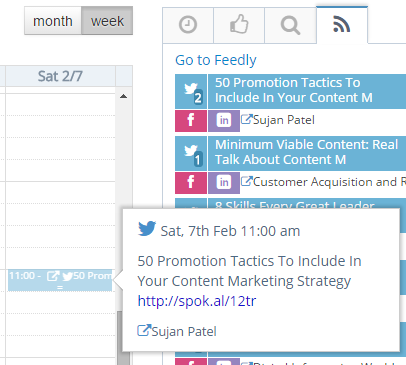Blogging for your business is, as we all know, essential to any Inbound Marketing strategy. It helps establish your company as a thought leader, it brings in new site traffic, and it converts that traffic into leads and customers.
But it’s not as easy as “build it and they will come” anymore. You can’t just write a blog and expect people to stumble across it on their many Google query travels. Sure, optimizing your content will help you be found through SERPs to a certain extent, but there’s also another – and often just as effective, if not more so – strategy at play: Social.
It’s not rocket science! Your audience loves social media, so you should too.
Becoming a Business People Love to Follow
But becoming a brand that everyone loves to follow isn’t easy, and it takes much more than self-promotion. It takes humor, patience, wit, 24/7 presence, a determination to educate, help and inform, and a desire to engage and entertain your customers.
While 74% of marketers claim to curate content on a regular basis, we all know that the reality is much different. Just look at some of the brands you follow on Twitter and tell me what you see?
Mostly self-promotion, right?
Right.
And it’s no surprise, really. While we know that the more you curate great content, the more people will click on your shared links, we also know that by sharing third party content, your own content is being pushed to the side.
Moreover, the ROI for content curation is difficult to track. Sure, you can look at follower/subscriber numbers, engagement levels and brand recognition, but the fact remains that the effect that content curation has on your business happens at a much more organic and social level.
So why would you spend so much time on an activity that may be good for you social media strategy, but not for your pocket?
- Because social media is where you can make a name for your business.
- Because social media is where people can find you.
- Because adding value, entertainment, education, information to the lives of our customers is what we’re here for.
- Because social does have an effect on how visible you are on the web.
- Because no man (or business) is an island.
I could go on and on, but I’ll stop there. Content curation is vitally important to your business, but it’s also a process that is under-valued, difficult to track and often time consuming.
So how do we get around these challenges?
What’s the Optimal (and therefore, minimum) Amount of Content We Should Curate?
Firstly, let’s figure out what the optimal (and therefore, minimum) amount of content we need to share is. Having a concrete number in mind will mean that you have a target to reach each day, and we all know the power of having targets.
A study run by Convince and Convert a few years ago, they found that linking to your own content between 25 – 50% of the time is a good percentage, with 40% being ideal.
That leaves 60% for curation/humor/conversations etc.
Personally, I like to follow a 40-40-20 rule. 40% curation, 40% self-promotion and 20% for other content (updates, humorous comments, Twitter chats, RTs etc.)
That means for every 1 piece of content I share, I also curate 1 piece of content. The formula makes it very simple for me to understand what my target for curating content is, even as our distribution quantity fluctuates (as it naturally does from time to time!)
How to Quickly Find Great Content to Curate
When I first began to curate content, I was assured (by many different sources) it would be a quick and easy process.
But the problem is that it’s not.
You’re not looking for any old content, you’re looking for content that you think is really useful, information, interesting, engaging and that makes you want to comment on and share with your audience.
That means digging through a lot of coal before you find a diamond.
Which means that you spend a lot of time reading content that you won’t curate.
Then when you do find something inspiring, you then need to draft up an interesting comment on it, and then create a social post with the appropriate links, hashtags and with the correct attribution (where it was published and the author of the post if possible).
To find out what the perfect curated post should look like, check out this post.
Realistically, each piece should take you about 10 – 15 minutes to curate. And with anywhere between 1 – 50 pieces (I exaggerate slightly here, but it varies wildly from business to business) of content needed, and with all the rummaging through content that doesn’t meet your standards, that time all adds up.
How to Speed Up Your Content Curation Process Without Sacrificing Quality
I’m not going to give you a huge list of content curation tools because…
- It’s been done to death.
- It’s been done really well to death.
What I do want to talk to you about is 2 in particular: Buffer & Feedly.
Why?
Because they both have fantastic browser add-ons which streamlines the content curation process, without you ever having to sacrifice quality.
Buffer (recommended for non-Spokal Users)
This is for non-Spokal users that don’t have access to our Editorial Calendar which syncs up with Feedly.
With Buffer you can curate content and automate scheduled sharing all in one app. Which means that when you come across content that you love, you can share it with your audience at scheduled times throughout the day.
The first thing you’ll want to do is get a Buffer account and connect it with all of your social media accounts. Then, download the Buffer Chrome extension (there’s one for Firefox too).
Now, when you’re reading content related to your industry that you find interesting, simply click on the extension that should appear beside your address bar and you’ll find that the following pop-up box appears.
Curate the content by adding your own insight on the piece and then choose whether you want to share it now, or schedule the post for later. The extension means that I never have to go between the page I’m reading and Buffer, so my reading isn’t interrupted by screen-hopping.
The ease of sharing (and creating ques of scheduled posts) means that curating content becomes a part of my reading-process – just like sharing posts on Facebook has become a part of my media consumption process.
With practice, you’ll find the whole practice of content curation becoming more and more organic. You read something, you find it interesting, you click buffer to share it, you comment on it, and you check your que to see what spaces you still have available.
It’s easy. It’s quick. It’s routine.
You spend 30 – 60 seconds curating each post, and before you realize it you’ve a que for an entire week of social sharing set up.
Feedly (recommended for Spokal users)
Feedly integrates quite closely with Spokal, so it’s my go-to tool when curating content on all things content marketing. (But it’s also a great web-based RSS reader for anyone!)
You can categorize feeds as you please, quickly scan through recently published content from your preferred sites, and “favorite” the very best for curation.
Feedly also offers one-click integration with Twitter, Google+, Facebook, and more.
If you are a Spokal user, you can connect Feedly with your Spokal account, which then allows you to tag your Feedly content with a “Spokal” tag.
This content will then show up on your Spokal content calendar.
Once you drag and drop your curated content into the calendar, you can easily schedule where and when to share it, while also adding your own comments to the post.
Like Buffer, Feedly has an amazing add-on extension that allows you to easily and quickly add third party content to your feed, tag the post so that it will show up in your Spokal calendar, email it to friends, share it on social media or save it for later.
After downloading the add-on you’ll find it in two places: On your bookmark bar – where it will take you straight to your Feedly feed and very discreetly at the bottom right hand corner of every webpage.
All you have to do to tag the page (or share it, save the blog, email it etc.) is click on the icon and select your preferred option from the list that emerges.
Easy, am I right?
Again, the extension means that curating can become a part of your reading process. Instead of taking an hour or two out of your day to scrounge for content, you simply tag content that actually interests you as you organically find it.
Then, when you go to schedule your posts for the next day (or week, or month etc.) you’ll find all the content that you’ve tagged with “Spokal” waiting for your curating fingers to work their magic in the Editorial calendar!
Conclusion
Content curation is really important, but the fact that it’s hard to track, can be time consuming, and not directly concerning your business, means that it’s often undervalued as a content marketing strategy.
To combat this, it’s best to create a content curation strategy that seamlessly flows with your day-to-day routine already. With a bit of practice with using Feedly and Buffer, curating content will become part of your everyday reading.
In no time you’ll be providing engaging, entertaining and educational content to your audience (regardless of who wrote it), making you a brand that people love to follow.
Need some help with your content marketing?
 Could you use an A-Z online marketing dictionary? Or a blogging template? How about some big content idea guides? We've got them all!
Could you use an A-Z online marketing dictionary? Or a blogging template? How about some big content idea guides? We've got them all!







